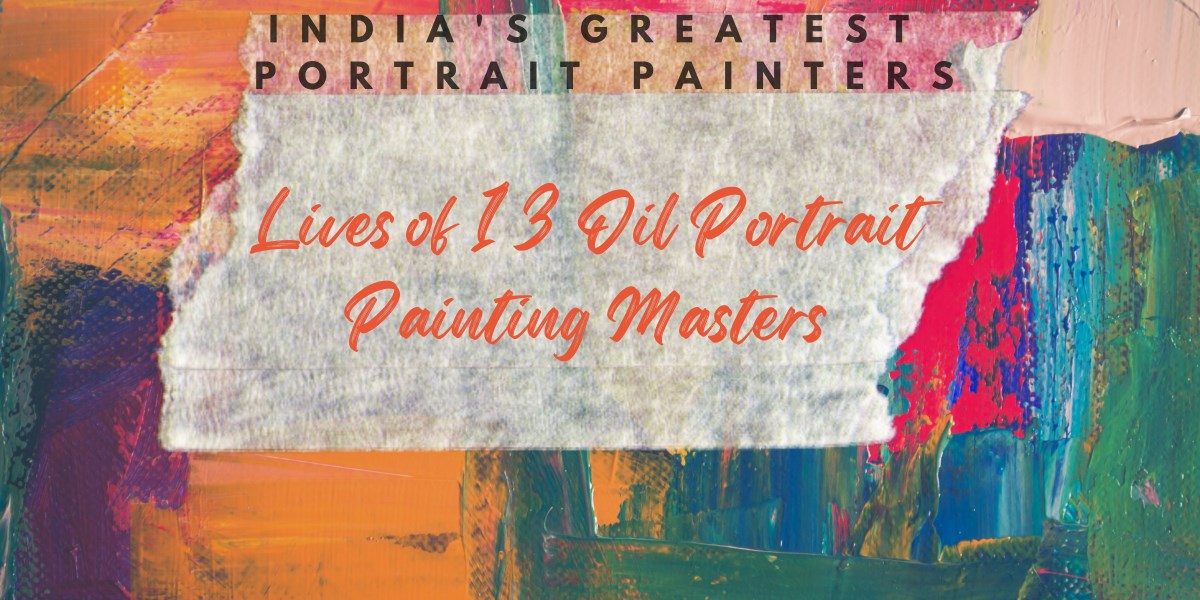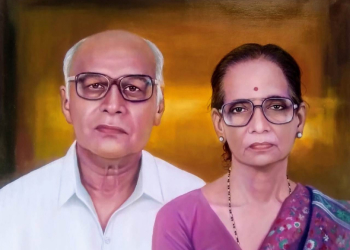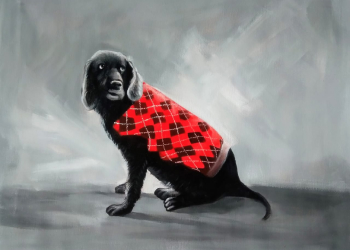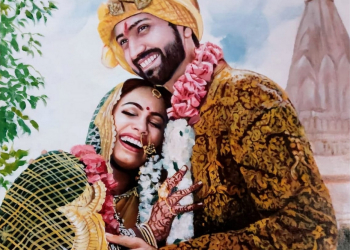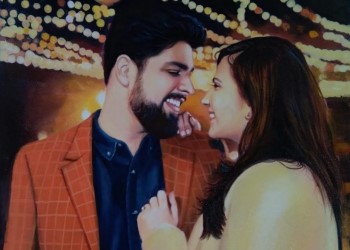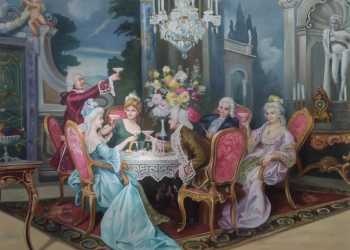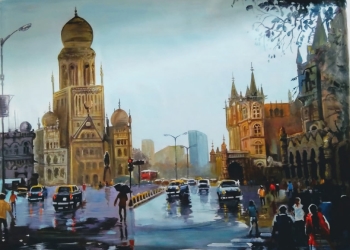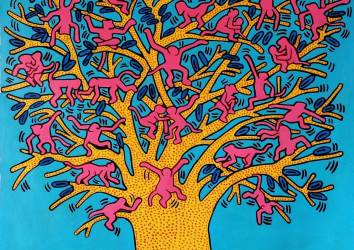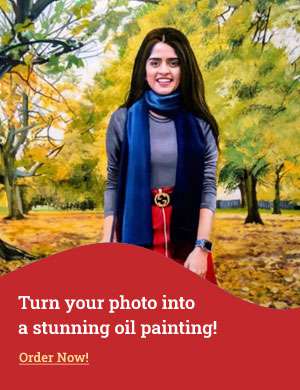The wild success of Raja Ravi Varma’s portraiture and paintings, and the establishment of art schools and institutions inspired a whole crop of new artists to step into the art world. We profile 13 of the very best portrait painters and artists that India ever produced. The post came over 8000 words long so we broke it into two parts. Posted here is Part II of the series. You can read the earlier post Part I
India's Greatest Portrait Painters: Lives of 13 Oil Portrait Painting Masters - II
In this post (Part II), we profile 7 (seven) of the 13 very best portrait painters and artists of India at that time. In the earlier post (Part I) we profiled the first (6) six of the 13 painters. The list is arranged chronologically in order of their births.
A. H. Müller
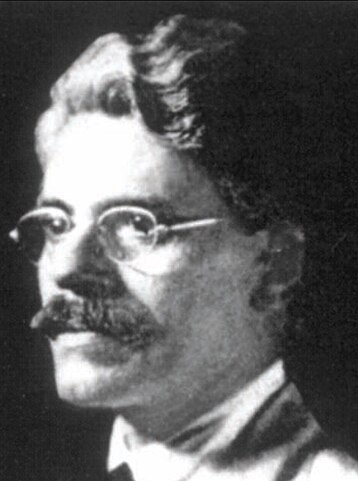 Painter & Artist Archibald Herman Müller (1878-1960) (Image Credits: Wikipedia Commons)
Painter & Artist Archibald Herman Müller (1878-1960) (Image Credits: Wikipedia Commons)
Archibald Herman Müller (1878 – 1960) was a remarkable portrait painter and artist known for his realistic portraits and paintings. Born in Cochin to a German Protestant father and an Indian Catholic mother, Müller possessed extraordinary artistic talents, unwavering dedication to his craft, and a strong sense of integrity.
After completing his education at the Madras Art School and a brief stint at his brother's photographic studio, Müller made his way to Mumbai, the artistic hub of India, in 1910. The following year, he achieved recognition by winning the prestigious top award in painting from the Bombay Art Society for his work titled "Princess Giving Gift to a Brahmin Boy." This oil painting was inspired by Ravi Varma's artwork on a similar theme. Unfortunately, despite this accolade, Müller struggled to secure a steady income and found himself reduced to tutoring art students from his humble abode.
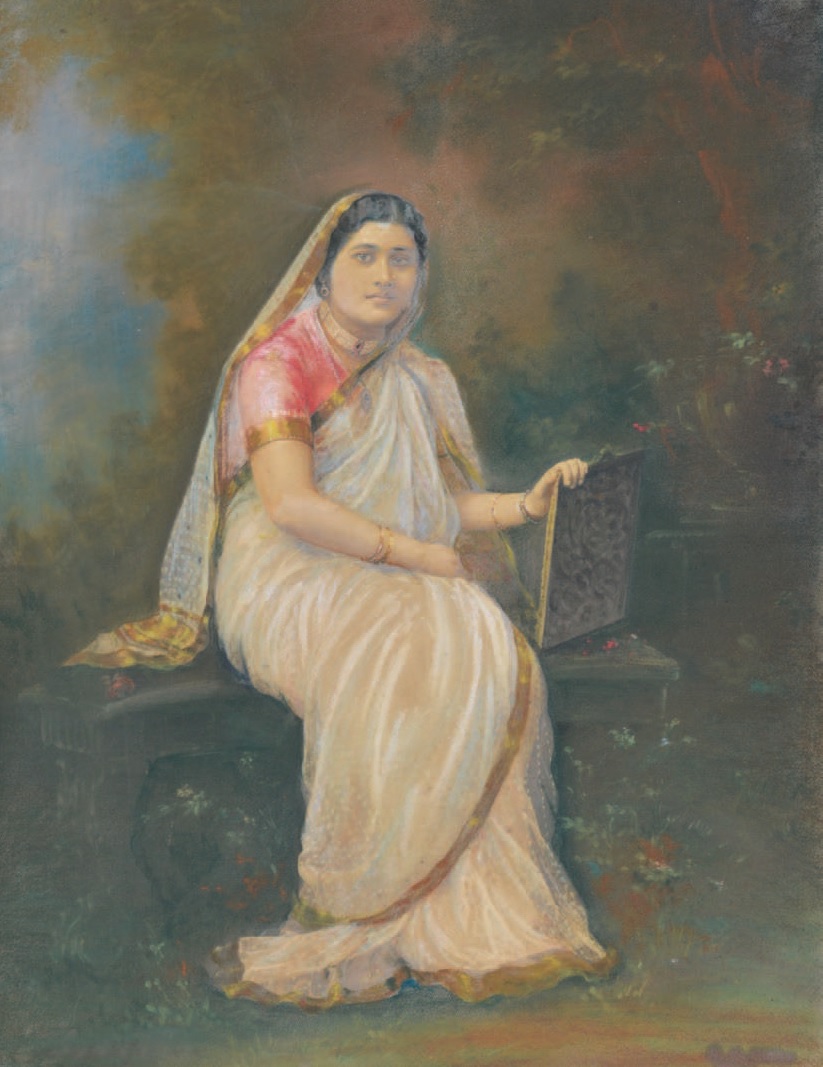 Lady Holding A Mirror by A. H. Müller (Image Credits: The Indian Portrait)
Lady Holding A Mirror by A. H. Müller (Image Credits: The Indian Portrait)
Title: Lady Holding A Mirror
Creator: A. H. Müller
Date Created: 1920
Physical Dimensions: 22 inches x 16.5 inches ( 55.88 cm x 41.91 cm)
Medium: Oil portrait painting on paper
Müller's paintings stood out for their meticulous understanding of human anatomy, lending his naturalistic approach a precise and compelling quality. His masterful compositions skillfully incorporated multiple figures, displaying fluidity and elegance. Among his notable works were historical and mythological narrative paintings such as "Ganga's Descent into Patala," "Shakuntala in Dushyanta's Court," "Krishna and Arjuna at Kurukshetra," and "Draupadi's Vastra Haran."
Throughout his career, Archibald Müller faced considerable hardships. However, he never compromised his artistic vision or his principles. According to art historian Partha Mitter, there were instances where a client requested minor revisions to one of Müller's paintings, but rather than altering the artwork, Müller chose to refund the client. On another occasion, when displeased with a patron, he boldly tore up his painting in front of them. Despite his challenging financial circumstances, he declined an offer from the wife of the Bombay Governor to purchase one of his paintings, as he had already promised it to a friend.
Eventually, poverty compelled Müller to seek employment with the Maharaja of Bikaner in 1922. His task was to document the ruler's hunting expeditions. However, he soon abandoned this position as it took away valuable time from his larger artistic compositions. Müller returned to Bombay and subsequently got married. Although he received another award from the Bombay Art Society, his financial situation remained difficult. Eventually, with a family to support, he ventured back to Rajasthan and assumed the role of the State Artist of Jodhpur.
Müller's portraits and depictions from epic narratives earned him multiple awards and critical acclaim. His artwork was showcased in museums worldwide and acquired by esteemed private collections such as Buckingham Palace in London and the South Kensington Museum (now known as the Victoria and Albert Museum). Several of his paintings also found their home in museums in Sangli, Maharashtra, Bikaner, Rajasthan, the Jodhpur Fort, and the Royal Palace in Jaipur. Müller's paintings continue to be highly sought after, often surfacing in various auctions in recent years. He was among the select few artists of his era to witness the dawn of independent India, leaving behind a lasting artistic legacy.
Fyzee Rahamin
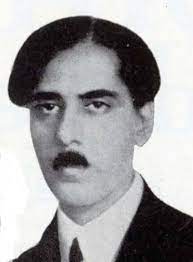 Portrait Artist & Painter Samuel Fyzee Rahamin (1880-1964), (Image Credits Wikipedia commons)
Portrait Artist & Painter Samuel Fyzee Rahamin (1880-1964), (Image Credits Wikipedia commons)
Samuel Fyzee Rahamin, (1880-1964) was born in Pune, India. A talented artist and portrait painter he initially received training at JJ School of Art in India before venturing to London to enroll at the prestigious Royal Academy Schools. There, he had the privilege of being taught by renowned artists such as John Singer Sargent and Solomon J. Solomon. However, upon returning to India in 1908, Rahamin made a significant shift in his artistic style. He abandoned the loose brushwork technique inherited from Sargent and instead became increasingly dedicated to revitalizing the traditional style of Indian painting.
In 1912, Samuel Rahamin married Atiya Begum, a member of the influential Fyzee family, and as a result, he converted to Islam and adopted the name Fyzee Rahamin.
At the turn of the twentieth century, Fyzee Rahamin's career was evidence of the globalization of art and culture. In 1914, he held his first exhibition at the Galerie Georges Petit in Paris, while living in Bombay (now Mumbai). His work also found acclaim in the United Kingdom and the United States, including participation in the 1924 British Empire Exhibition at Wembley. It was reported in Burlington Magazine in 1926 that his watercolor exhibition at the Arthur Tooth & Sons Gallery was entitled "Water Colors, India, Vedic, Mythological and Contemporary." At the American Association in New York, he held a "Special Exhibition" in May 1939 exhibiting "Modern Indian Art on traditional lines."
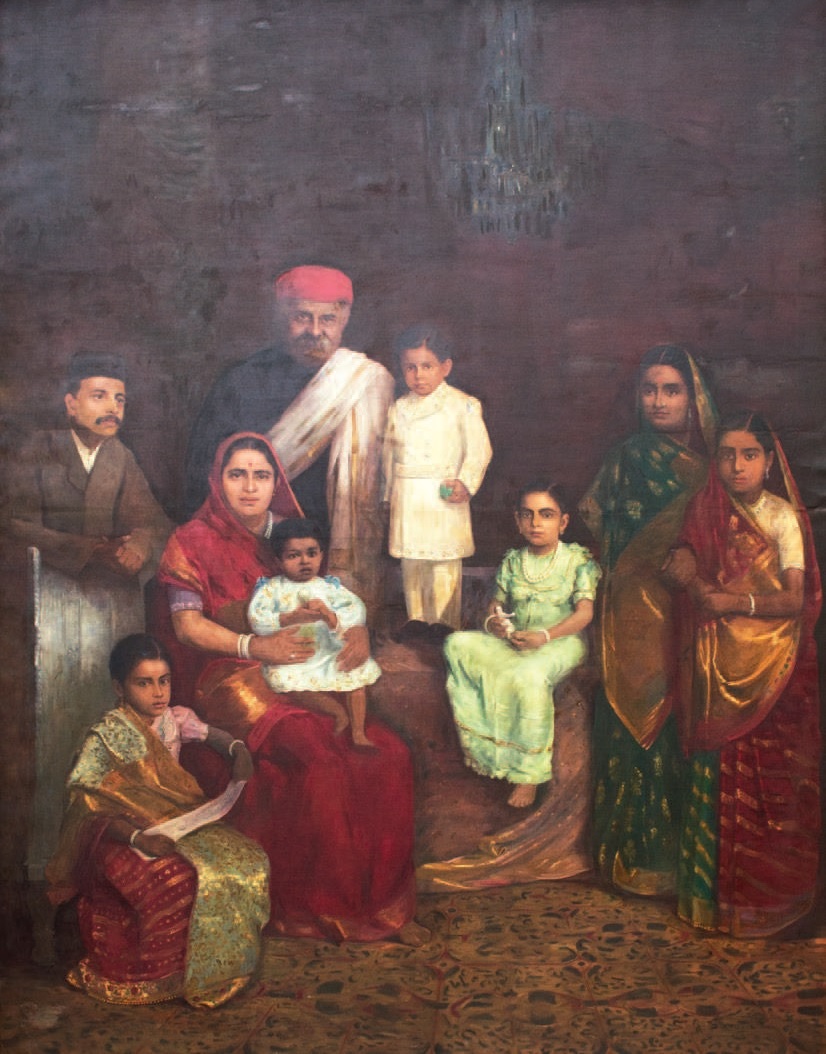 Family Portrait Painting of Sir Chinubhai Baronet and Family by Samuel Fyzee Rahamin (Image Credits The Indian Portrait)
Family Portrait Painting of Sir Chinubhai Baronet and Family by Samuel Fyzee Rahamin (Image Credits The Indian Portrait)
Title: Family Portrait Painting of Sir Chinubhai Baronet and Family
Creator: Samuel Fyzee Rahamin
Date Created: 1910
Physical Dimensions: 108.3 inches x 84.3 inches ( 275.08 cm x 214.12 cm)
Medium: Family Oil portrait painting on canvas
Order Your Custom Handmade Oil Portrait Painting from Photo today
Samuel Fyzee Rahamin's expertise as an artist extended beyond exhibitions. He was appointed as an art advisor to the state of Baroda, contributing to the preservation and development of artistic heritage. Additionally, he was commissioned to paint frescoes for the Imperial Secretariat in New Delhi during the years 1926-1927 and 1928-1929. In 1928, Rahamin approached William Rothenstein with the aim of being recommended to paint the proposed murals in India House in Aldwych. However, due to seniority issues, he was not ultimately appointed for the task.
In addition to his artistic pursuits, Fyzee Rahamin actively engaged with institutions such as the Victoria and Albert Museum and the Metropolitan Museum in New York. He lent his expertise to the reorganization of collections of Asian art, leaving a lasting impact on the curation and preservation of cultural heritage. Moreover, Fyzee Rahamin was a talented writer, publishing plays and poetry throughout his career.
Following the partition of India in 1947, Samuel Fyzee Rahamin emigrated to Karachi, where he died in poverty. His remarkable art collection is now showcased at the Fyzee Rahamin Art Gallery. Examples of his work can also be found in prominent institutions such as Tate Britain and Manchester City Art Gallery.
Rustom Siodia
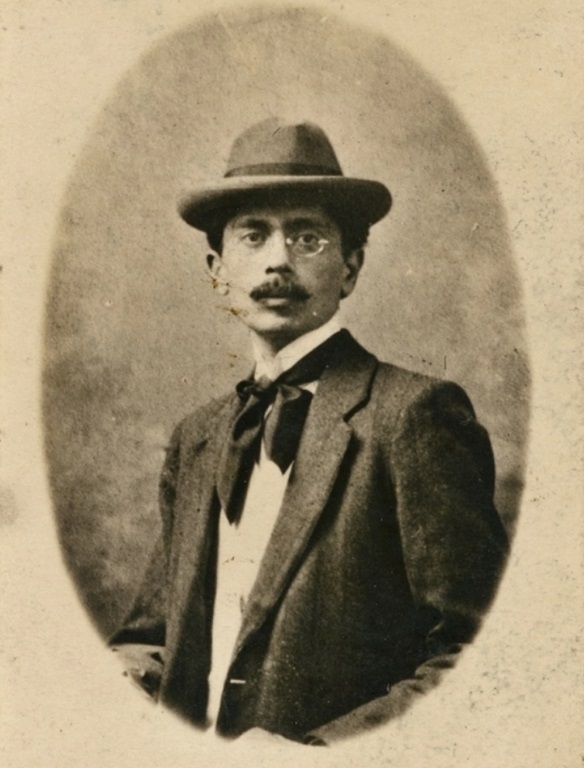 Portrait Painter & Artist Rustom Siodia (1881-1946) (Image Credits: Parsi Khabar)
Portrait Painter & Artist Rustom Siodia (1881-1946) (Image Credits: Parsi Khabar)
Rustom Siodia (1881-1946), born in 1881 in Bombay to a Parsi family, emerged as an artist and portrait painter during a period of significant change in the city. Showing early potential, he enrolled at the Sir JJ School of Art and later pursued further studies at the Royal Academy of Arts in London under John Singer Sargent. Returning to India in 1913, Siodia established a studio in Bombay and received numerous commissions, including prestigious ones for mural paintings at the Imperial Secretariat in New Delhi and the Royal Opera House in Bombay.
His most productive period spanned from 1915 to 1939, during which he produced a substantial body of work and showcased his talents as a muralist. Notable among his achievements was winning the British Government's competition for interior decoration at the Imperial Secretariat, where his murals displayed diverse themes influenced by his British education and exploration of Persian elements.
Despite his success, Siodia gradually faded into obscurity after his death in 1946. However, one of his portraits can be found at the CSMVS museum in Mumbai, representing the artistic contributions of the Sir JJ School of Art.
Siodia's legacy as a pioneering artist in India, his remarkable murals, and his exploration of diverse themes leave a lasting impression on the art scene, even though his recognition has waned over time.
You can learn more about the life and works of Rustom Siodia in our previous post, Mumbai’s Parsi Portrait Painters
S. L. Haldankar
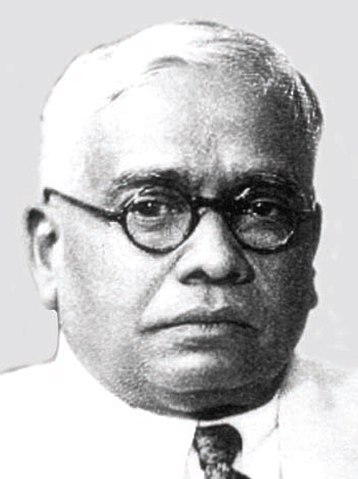 Artist & Portrait Painter Sawlaram Lakshman Haldankar (1882-1968) (Image Credits: Wikipedia Commons)
Artist & Portrait Painter Sawlaram Lakshman Haldankar (1882-1968) (Image Credits: Wikipedia Commons)
Sawlaram Lakshman Haldankar (1882–1968) was a well-known Indian artist and master portraitist.
He was born in Sawantwadi, formerly Princely State in today's Sindhudurg district of Maharashtra. Tragically, he lost his father at the tender age of three, but this setback did not hinder his determination to pursue his passion for art.
Haldankar received his early education in Sawantwadi, where he completed his studies up to the Matriculation level. Displaying a talent for art at a young age, he sought guidance from his art teacher N. S. Malankar, under whose tutelage he successfully passed the two-grade examination. His headmaster encouraged him to pursue art and commended him to the local Raja Saheb of Sawantwadi, who gave him a scholarship to pursue skills in Bombay.
Haldankar's artistic journey began to unfold in 1903 after enrolled in the art school, in pursuit of further honing his skills. While at the Institution, he had the privilege of learning from esteemed teachers such as Cecil L. Burns, M.V. Dhurandhar, Walter Robotham, Ganpatrao Kedari, A.K. Trinidade, and S.P. Agaskar. Their expertise and mentorship played a pivotal role in shaping Haldankar's artistic style and techniques. He distinguished himself by winning several prizes at a young age. He was particularly talented in watercolors and showed unusual mastery over portrait paintings.
After graduating from JJ School of Art, Haldankar taught art in the same institution for a few years before leaving it to found Haldankar Fine Arts Institute in Bombay in 1908. A decade later, in 1918, he collaborated with fellow artists to establish the Art Society of India, where he served as its President for numerous years.
Haldankar's profound dedication to his craft propelled him to the forefront of the art scene, earning him an impeccable reputation. He became known for his portraits, receiving several commissions from industrialists, politicians, and royalty. Throughout his illustrious career, he created captivating portraits of prominent figures such as Pandit Madan Malaviya, Jagannath Sunkersett, Sir John Beaumont, Lady and Sir Leslie Wilson, and the Raja Saheb of Sawantwadi.
Haldankar’s most iconic creation is a portrait painting of his daughter Gita Haldankar (later Smt. Gita Krishnakant Uplekar) holding a lamp as twilight gathered around her. The critically acclaimed and most loved painting The Glow of Hope, aka The Woman with the Lamp, is on display at Sri Jayachamarajendra Art Gallery at the Jaganmohan Palace in Mysore, India.
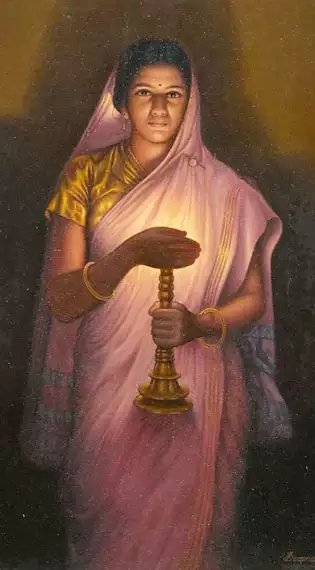 Glow of Hope by Sawlaram Lakshman Haldankar (Image Credits: Sri Jayachamarajendra Art Gallery, Mysore)
Glow of Hope by Sawlaram Lakshman Haldankar (Image Credits: Sri Jayachamarajendra Art Gallery, Mysore)
Title: Glow of Hope Aka, Woman with the Lamp
Creator: Sawlaram Lakshman Haldankar
Date Created: 1945-46
Medium: Water Color on Paper
Location: Sri Jayachamarajendra Art Gallery, Mysore, Karnataka
Order Your Portrait Painting from Photo today!
Haldankar's artistic prowess gained recognition through numerous exhibitions where he showcased his masterful works. Haldankar held several exhibitions in Mumbai, Chennai, and Simla, which further solidified his position as a distinguished artist. In 1914, his talent transcended borders as he participated in the exhibition organized by the Royal British Society of Arts, London.
Haldankar's exceptional talent and relentless pursuit of artistic excellence garnered him numerous accolades throughout his career. During his time at the J.J. School of Art, he consistently emerged as a leading artist, winning a multitude of prizes and establishing himself at the top echelons of the institution. The Royal Society of British Artists gave him two commendation certificates. In 1910, 1927, and 1932, he was given the Governor's Prize by the British Government of the Bombay Presidency. After Independence S.L. Haldankar was honoured by India's President, Dr. Rajendra Prasad. And he was named a fellow of the Lalit Kala Akademi in New Delhi.
Haldankar actively engaged in various art activities, assuming leadership roles in important committees and societies. His affable nature and steadfast convictions, derived from a rich tapestry of experiences, cemented his influence within the art community.
Over the years, Haldankar's artwork continued to captivate audiences, leading to notable joint retrospective exhibitions in 1998-99 and subsequent displays in 2004 and 2005. These exhibitions, including the prestigious Manifestations series, served as platforms to showcase his artistry.
The profound impact of Haldankar's artistic creations can be witnessed through their inclusion in renowned collections worldwide. His artworks can be found in esteemed institutions such as the Prince of Wales Museum in Mumbai, the National Gallery of Modern Art (NGMA) in New Delhi, the Jagmohan Palace in Mysore, the Nagpur Museum in Nagpur, and the Academy of Art in Moscow, USSR. These prestigious collections serve as testaments to the enduring legacy of Haldankar's artistic brilliance.
J. A. Lalkaka
 Portrait Artist and Painter J. A. Lalkaka (1884-1967) (Image Credits: Internet Archives)
Portrait Artist and Painter J. A. Lalkaka (1884-1967) (Image Credits: Internet Archives)
Jehangir Ardeshir Lalkaka aka J. A. Lalkaka (1884-1967), an eminent Indian artist and portrait painter, was born in Ahmedabad, Gujarat.
Lalkaka's artistic education began at the Ahmedabad High School in his hometown and further continued at Elphinstone College in Bombay. Seeking to refine his skills, he embarked on a transformative journey by enrolling at the J.J. School of Art in Bombay from 1903 to 1907. Recognizing his talent and potential, his grandfather, Sir Navroji Vakil, sent him to Europe for higher studies. In 1908, he set off for London to pursue higher studies, attending the St. John's Wood and Westminster School of Art. It was during this period that he had the privilege of learning the art of portrait painting from the esteemed artist A. Stanhope in Paris. These formative years of education played a pivotal role in shaping Lalkaka's artistic style and technique.
In 1913, Lalkaka returned to India and established his own studio in Bombay as a portrait painter. His remarkable talent and exquisite portraits earned him widespread acclaim, particularly from the governing elite, with the support and patronage of Viceroys Irwin and Willingdon.
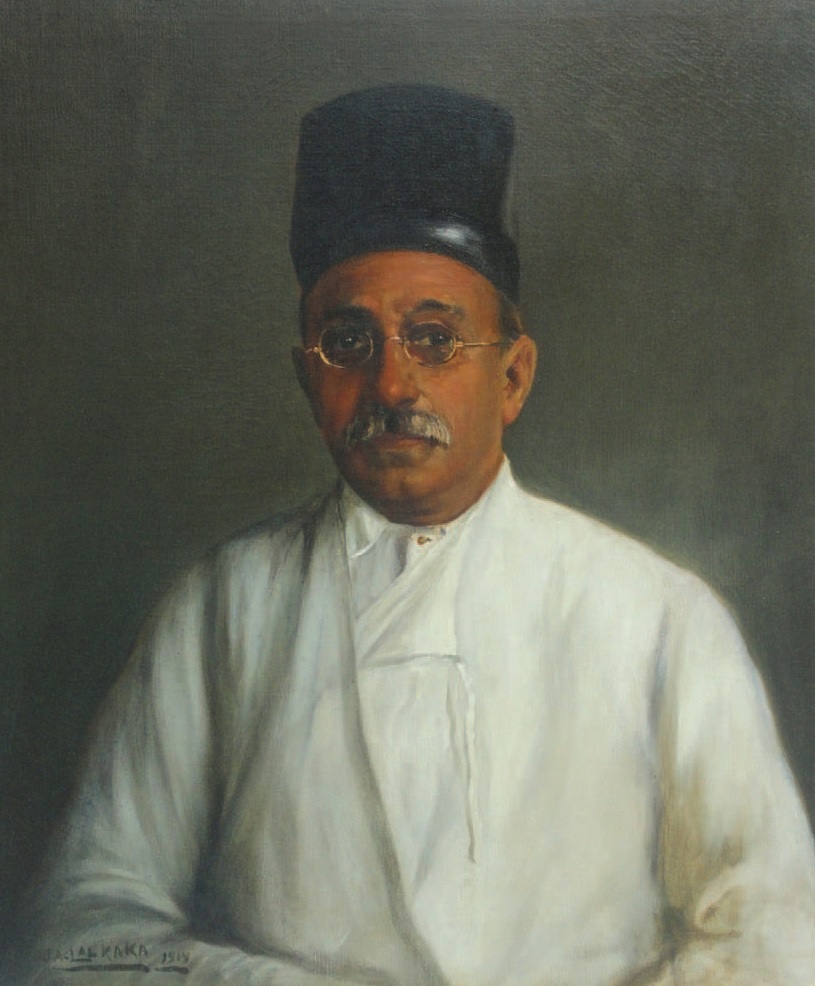 Portrait Painting of Ardeshir Cawsji Engineer by J. A. Lalkaka (Image Credits: The Indian Portrait)
Portrait Painting of Ardeshir Cawsji Engineer by J. A. Lalkaka (Image Credits: The Indian Portrait)
Title: Oil Portrait of Ardeshir Cawsji Engineer
Creator: J. A. Lalkaka
Date Created: 1919
Physical Dimensions: 29.5 inches x 23.6 inches ( 74.93 cm x 59.94 cm)
Medium: Oil portrait painting on canvas
The Viceroy and Lady Irwin of London notably commended his painted royal portraits for their exceptional quality. In 1931, upon his return from England, Lalkaka was honored with a reception organized by the members of the Art Society of India at the society’s hall in Girgaum. He made history as the first Indian to be appointed as the Deputy Director of the J.J. School of Art by the Government of Bombay from 1931 to 1933. These accolades and achievements serve as a testament to Lalkaka's significant contributions to the art world.
Lalkaka's artistic prowess was showcased in various exhibitions, strengthening his position as a respected artist. Notably, he participated in a group exhibition organized by the Delhi Fine Arts Exhibition Society in New Delhi. He also contributed to the annual exhibitions held by the Bombay Art Society in Bombay, exhibiting his works in 1936, 1940, and 1944.
In 2005, Lalkaka's artistry was featured in the prestigious Manifestations III exhibition at Nehru Center in Mumbai, and the Lalit Kala Akademi in New Delhi. These exhibitions served as platforms to display Lalkaka’s work and remarkable talent.
Lalkaka's commitment to fostering artistic talent extended to his role as the Dean of the J.J. School of Art in Bombay. His leadership and expertise guided aspiring artists, nurturing their skills and shaping the next generation of artistic talent. His contributions as an educator left an enduring imprint on the art community, cementing his legacy as a revered figure in Indian art.
Lalkaka's exceptional artworks are found in esteemed collections around the world. Notably, his portraits adorn the halls of the Rashtrapati Bhavan in New Delhi, showcasing his contribution to the decoration of the Viceroy's Palace. Additionally, his works can be found in the collection of the Bombay Art Society in Mumbai, the esteemed Buckingham Palace in London, and the Delhi Art Gallery in New Delhi. These collections stand as testaments to the lasting impact and artistic brilliance of Lalkaka's creations.
J. A. Lalkaka's artistic journey exemplifies a remarkable blend of talent, education, and dedication to his craft. His passion for portrait painting, refined through his European training, captivated the hearts of patrons and art enthusiasts alike. With his extraordinary talent, Lalkaka's legacy continues to inspire artists and art lovers all over.
Ravishankar Raval
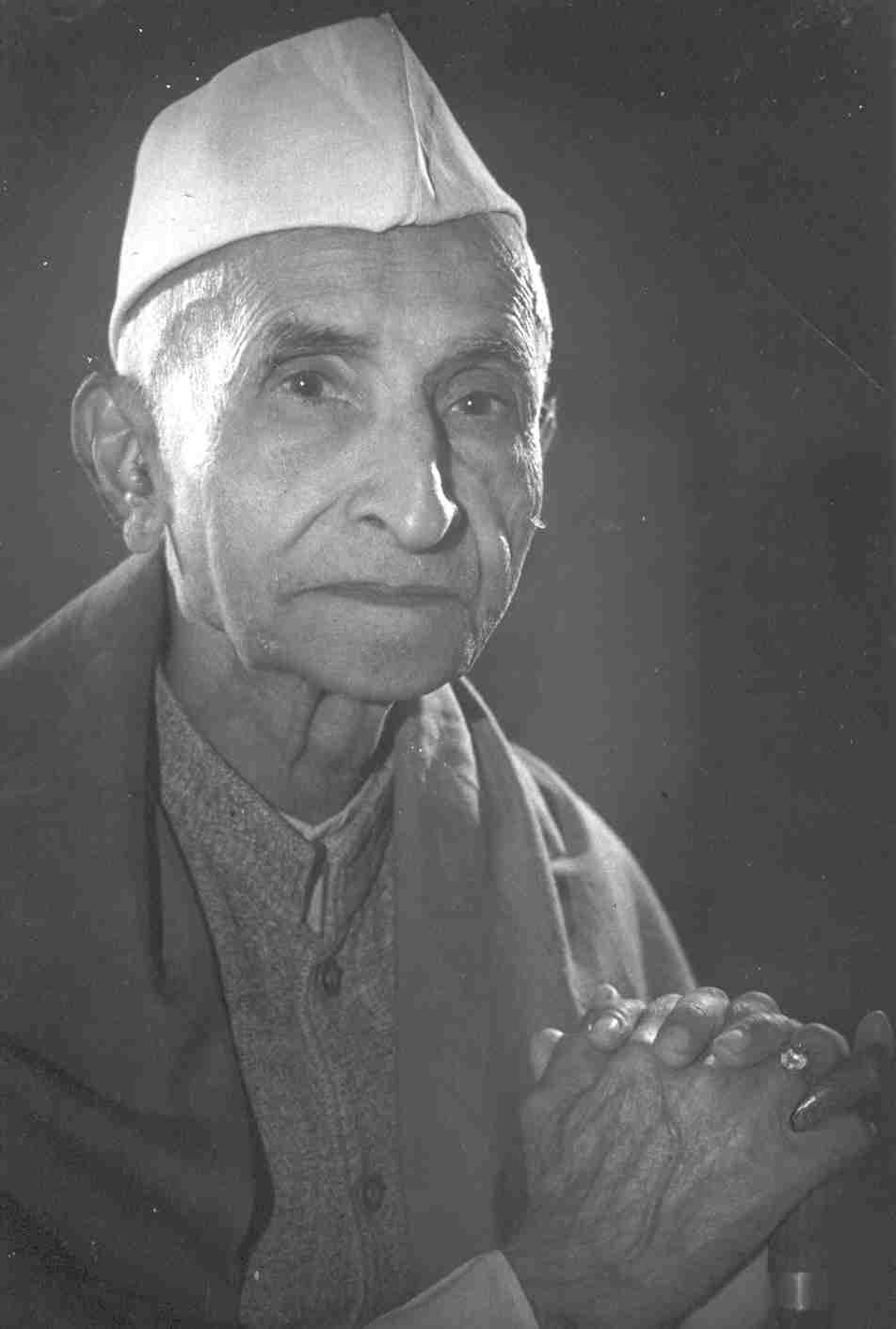 Artist & Portrait Painter Ravishankar Raval (1892-1978) (Image credits: Wikipedia Commons)
Artist & Portrait Painter Ravishankar Raval (1892-1978) (Image credits: Wikipedia Commons)
Ravishankar Raval (1892-1978) was a renowned Indian artist and portrait painter born into a Brahmin family in Bhavnagar, Gujarat, in 1892. His early exposure to Raja Ravi Varma's paintings at the Bhavnagar Palace sparked his interest in art. Despite his postmaster father's desire for him to become an engineer, Raval's exceptional talent led him to enroll at the prestigious JJ School of Art, against his father's wishes. Under the guidance of Cecil Burns, the principal of J.J. School, Raval's artistic abilities flourished, earning him recognition and numerous accolades.
In 1915, Raval was awarded the Gujarati Sahitya Parishad silver medal, followed by the Mayo gold medal of JJ Art School and the Bombay Art Society Prize in 1916. His outstanding skills and dedication to his craft were further acknowledged when he received the Kalidas Prize in 1925. Notably, during this period, Raval was commissioned to create a portrait painting of a European principal from a local college, for which he received a substantial sum of Rs 1200.
Although his career as a salon portrait artist was promising, Raval made the conscious decision to return to Gujarat in 1919 and became an ardent follower of Mahatma Gandhi. This was a time of political upheaval in India, as people increasingly sought liberation from oppressive British colonial rule. Gandhi emerged as a prominent leader of the freedom struggle, advocating for a complete severance from British colonial institutions. Inspired by Gandhi's teachings, Raval renounced European academic art and embraced a more indigenous artistic style.
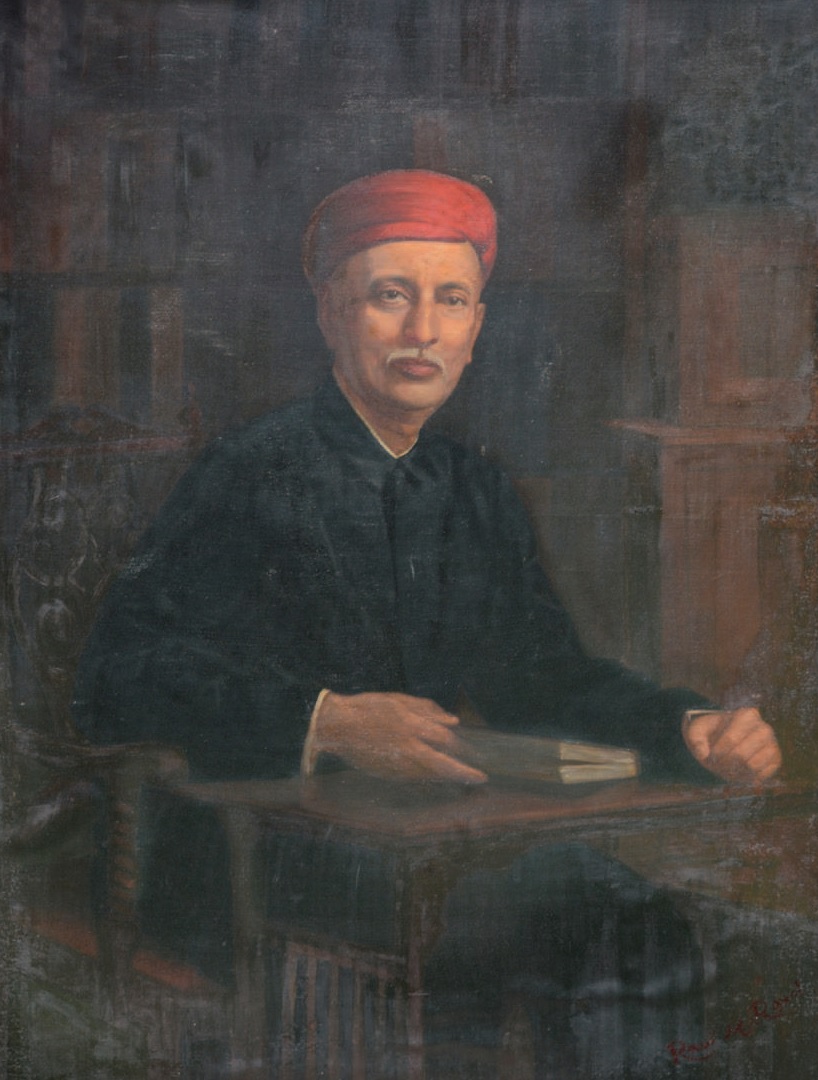 Oil Portrait of Keshavlal Harshadrai Dhruv by portrait artist and painter Ravishankar Raval (Image credits The Indian Portrait)
Oil Portrait of Keshavlal Harshadrai Dhruv by portrait artist and painter Ravishankar Raval (Image credits The Indian Portrait)
Title: Oil Portrait of Keshavlal Harshadrai Dhruv
Creator: Ravishankar Raval
Date Created: 1925
Physical Dimensions: 48 inches x 36.2 inches ( 121.92 cm x 91.94 cm)
Medium: Oil portrait painting on canvas
In 1922, Raval gained widespread recognition when he depicted the trial of Mahatma Gandhi on the charges of sedition after the Chauri Chaura incident. The trial took place on 18 March 1922 in the Circuit House of Ahmedabad, where cameras were not allowed. Raval's painting captured this historic event, elevating him to national prominence. In 1930, Raval and Nandalal Bose were entrusted with decorating the Haripura Congress Venue, an honor bestowed upon them by Gandhi himself.
Raval's artistic journey took him on a path of exploration and discovery. In 1927, he embarked on a month-long study of the first-century frescoes at the Ajanta Caves, delving into the rich artistic heritage of India. In 1936, he embarked on a three-month art tour to Japan, immersing himself in the artistic traditions of another culture. During this period, his art evolved and began to reflect the influence of the Bengal School. In 1941, Raval visited Rabindranath Tagore's university, Santiniketan, where he had the opportunity to meet James Cousins, the Secretary of the Theosophical Society. Cousins was known for his support of young talents.
Cousins who backed many young talents, wrote,
" I was piloted through narrow streets odoriferously unclean, by narrow, dingy passages, and up the stairs into an untidy room. But in a few moments, squatted on the carpeted floor, I realized that the untidiness was fundamental, and like all good firmaments, held orbs and galaxies of beauty, the paintings of the artists who sat with me, each like a creative deity, presenting his constellation for my scrutiny. Thus began a friendship of souls with a genius for bringing the best out of young people who felt the impulse to expression in painting." That genius was Raval
In recognition of his contributions to the art world, Raval was appointed as the President of the Art Society of India and the President of the Bombay Art Society in 1941. Furthermore, he was honored with the Padma Shri, the fourth-highest civilian award in India, in 1965. In 1970, Raval was accepted as a Fellow of the Lalit Kala Akademi, an esteemed acknowledgment of his artistic accomplishments.
Ravishankar Raval's life was dedicated to his passion for art and his commitment to the principles of Mahatma Gandhi. His journey from a talented young artist to a renowned figure in the Indian art scene was marked by his unwavering dedication and artistic brilliance. His legacy continues to inspire generations of artists, and his contributions to Indian art remain integral to its rich cultural tapestry.
Hemendranath Majumdar
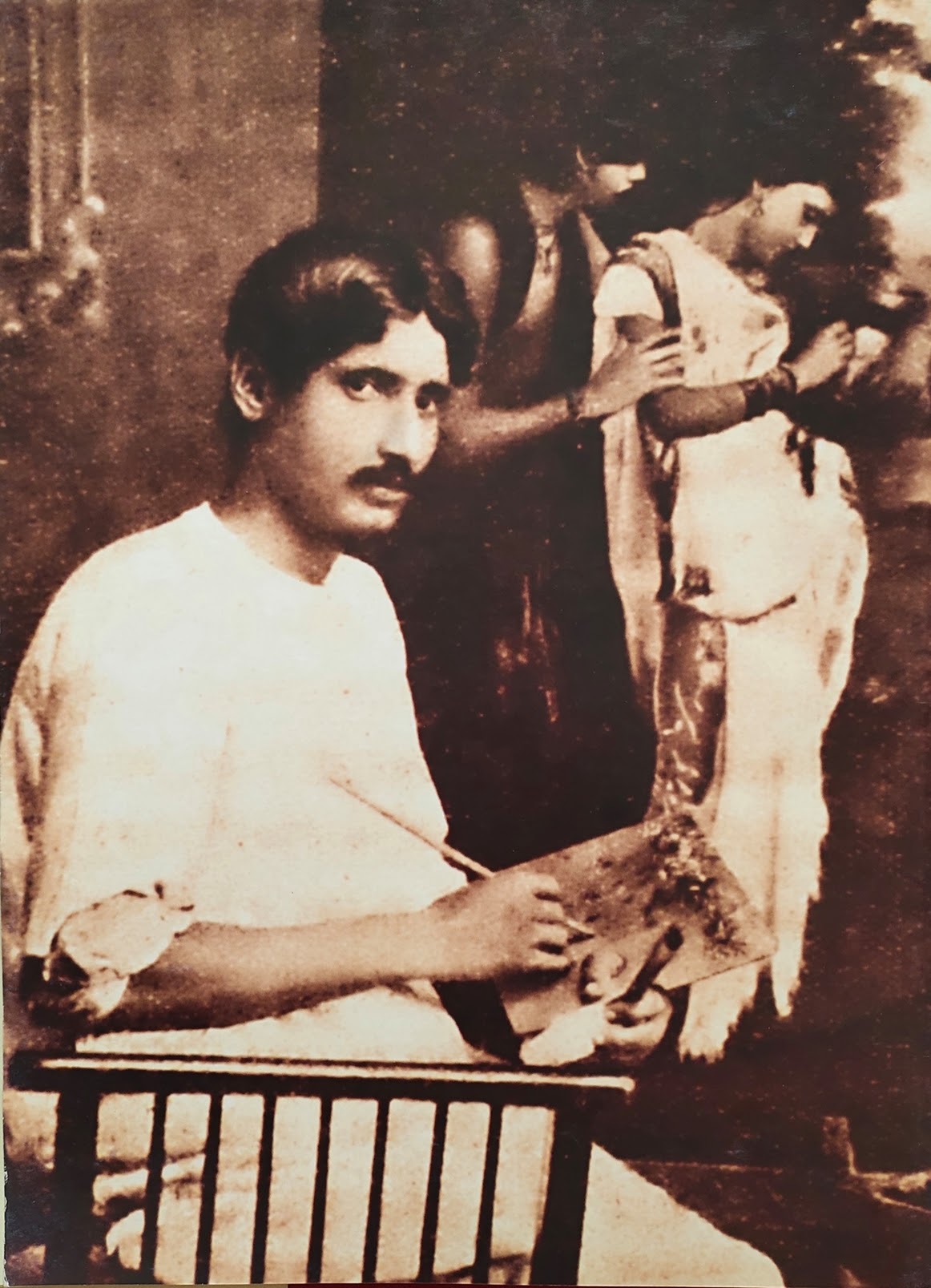 Artist and portrait painter Hemendranath Mazumdar (1898-1948) (Image Credits: Internet Archives)
Artist and portrait painter Hemendranath Mazumdar (1898-1948) (Image Credits: Internet Archives)
Hemendranath Majumdar (1898-1948), was an eminent Indian artist and portrait painter born in Kishoreganj, Bangladesh. Majumdar's artistic journey was marked by significant accomplishments and contributions to the realm of fine art.
In 1919, Hemendranath Majumdar, along with Jogeshchandra Seal, Jamini Roy, Bhabani Charan Law, and Atul Bose, founded the Indian Academy of Fine Art in Calcutta, a significant initiative that fostered artistic collaboration and development. Mazumdar's talent and artistic vision were acknowledged early on when he was bestowed the honor of decorating the gates to welcome King George V during his visit to India in 1911, showcasing his innate artistic abilities and attention to detail.
Majumdar's educational pursuits played a crucial role in shaping his artistic style and technique. In 1910, he joined the Government School of Art in Calcutta, laying the foundation for his artistic training. From 1911 to 1915, Hemendranath Majumdar further honed his skills at the Jubilee Art School in Calcutta, immersing himself in diverse artistic disciplines and exploring various artistic expressions.
Throughout his illustrious career, Majumdar participated in several prestigious exhibitions, showcasing his captivating artworks to a wider audience. In 1921, he exhibited his works at the Bombay Art Exhibition in Bombay, followed by an exhibition in Madras. His artistic prowess continued to be recognized, earning him the first prize at the Bombay Art Exhibition in both 1921 and 1922, a testament to his exceptional talent and artistic mastery.
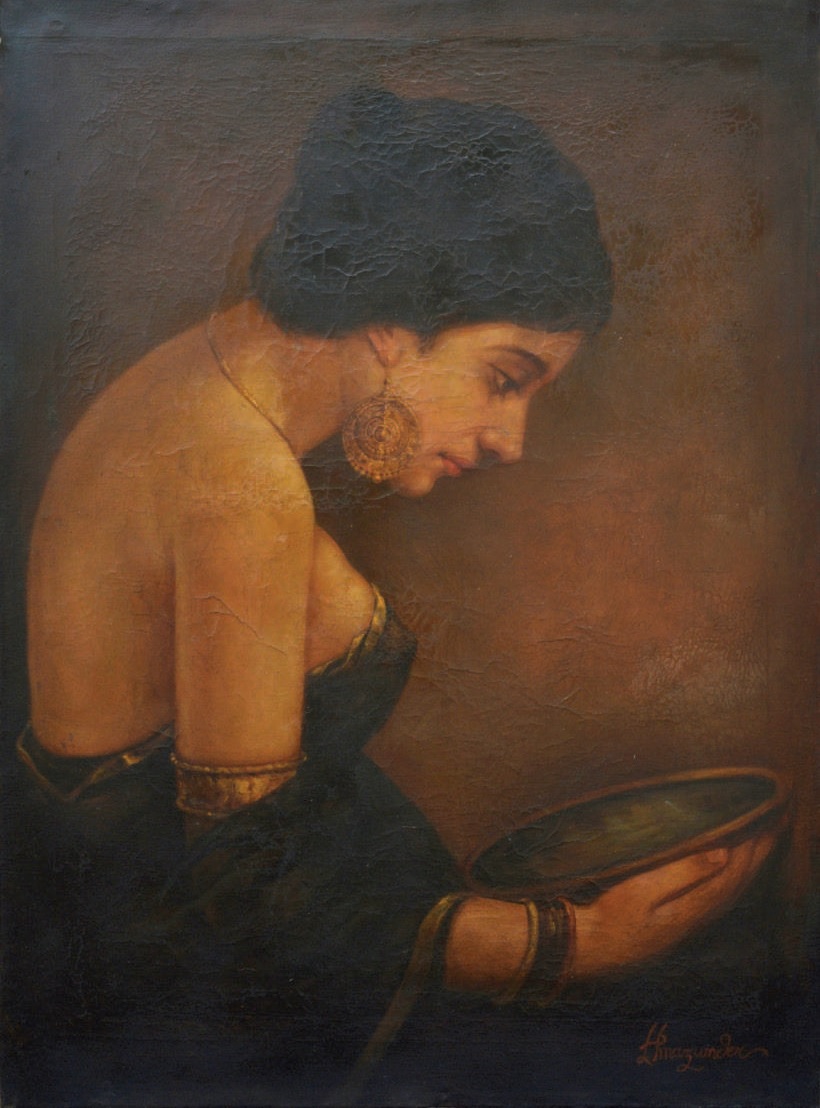 Oil Portrait Lady with Mirror by portrait artist and painter Hemendranath Majumdar (Image Credits: The Indian Portrait)
Oil Portrait Lady with Mirror by portrait artist and painter Hemendranath Majumdar (Image Credits: The Indian Portrait)
Title: Oil Portrait Lady with Mirror, For Kaushlyadevi, Queen of Nadia State
Creator: Hemendranath Majumdar
Date Created: 1940
Physical Dimensions: 43.7 inches x 31.9 inches ( 110.99 cm x 81.02 cm)
Medium: Oil portrait painting on canvas
Handmade Art Reproductions & Landscape Paintings
Mazumdar's artistic achievements extended beyond exhibition participation. Hemendranath Majumdar published the art journal "Shilpi," along with A.C. Mukhopadhyay, providing a platform for artists to exchange ideas and engage in meaningful discourse. Additionally, his notable contributions to the Indian Masters album, published by the Indian Academy of Fine Art, showcased some of his remarkable paintings, further solidifying his position as a prominent figure in the art community.
One of Mazumdar's notable artworks, "Cure of all Ills," holds significant historical and artistic value. Painted during his own illness, the piece depicts Mahatma Gandhi spinning thread, symbolizing the healing and transformative power of Gandhi's principles and the message of self-reliance.
Mazumdar's artistic legacy is evident in the wide range of esteemed institutions and private collections that house his works. His creations grace the collections of the Academy of Fine Art in Kolkata, the Bikaner Palace in Rajasthan, the Birla Academy of Art and Culture in Kolkata, the National Gallery of Modern Art in New Delhi, and the collections of various royal families, including the Mayurbhanj, Maharaja Prafulla Thakur, Maharaja Ranjit Singh, Maharaja Hari Singh, and Maharaja Jadabendranath Singh.
In recognition of his exceptional artistic contributions, Hemendranath Majumdar received numerous accolades throughout his career. His talents were acknowledged with the first prize at the Bombay Art Exhibition in 1921 and 1922, solidifying his position as a highly respected artist within the art community.
Hemendranath Mazumdar's artistic journey exemplifies a profound commitment to artistic excellence and the exploration of innovative, creative, artistic expressions. A lasting legacy of inspiration and influence on the Indian art scene, his contributions continue to inspire generations of artists.
Conclusion
In this Part, we completed the lives of 7 (seven) of the 13 best portrait painters in India. You can read our post Part 1 to learn more about the 6 artists of the 13 artists featured earlier.
We have explored the works and lives of thirteen incredible portrait painters and artists who have left a permanent mark on the Indian art scene. Each artist has a unique style and approach, showcasing their individuality and artistic visions inspired by the iconic portrait artist Raja Ravi Varma, whose realistic depictions revolutionized Indian art.
The legacy of these thirteen greatest portrait painters and artists of India serves as a testament to the power of art in capturing the essence of humanity and preserving it for future generations. Their exceptional talents, unique styles, and profound artistic visions have elevated the art of portraiture, showcasing the depth and diversity of human experiences. Their works not only celebrate the beauty and diversity of India's people but also provide insights into their history, culture, and identity. Making them not only skilled portrait artists but also chroniclers of their era. Through their brushstrokes, these artists have immortalized individuals and shared their stories with the world.
Through their talents and sheer determination, these artists have enriched our cultural heritage, and their legacy will continue to inspire generations of artists and art enthusiasts to come.
It is important to acknowledge that this list represents just a fraction of the immense talent and creativity present in India's art community. There are countless other portrait painters whose contributions deserve recognition and appreciation.
About Us:
Paintphotographs.com is India's leading custom art platform. We turn your favorite photos, pics, and images into luxurious handmade portrait paintings. Our work includes handmade portraits, custom oil reproductions, charcoal drawings, and sketches. As a team of accomplished artists, we use museum-quality canvas, the best international brands of colors such as Winsor & Newton and Daler Rawney. We work with various mediums, including oil, acrylic, mixed media, graphite, and charcoal.
To order a custom handmade oil portrait painting you can visit our order now page. You can order custom Wedding Paintings, Couple Paintings, Memorial Paintings, Family Paintings, Baby portraits and Children Paintings, Photo to paintings, and Pet Portrait Paintings from Photo.
You can visit our pricing page to know the prices of our portrait paintings. To connect with us ping us on our chat messenger on the website, ping us on WhatsApp, call us at 918291070650, or drop us an email at support@paintphotographs.com
You can visit our gallery pages to see our work. We make photo to paintings, couple paintings, memorial paintings, Kids and Baby Portrait paintings, God & Religious Paintings, Old Photo to Paintings, Wedding couple Paintings & Marriage Portraits, Family Paintings, Pet Portrait Paintings, Radha Krishna Paintings, Oil Portraits of Gurus, Saints & Holy Men, Charcoal and Pencil Sketches, Custom Landscape & Cityscape paintings, Contemporary Art Reproduction & Replica Paintings, Old Master Reproduction & Replica Art, Monochrome and Black & White portrait paintings, Historical Portraits and Shivaji Maharaj Paintings, Celebrity & Political Leaders Portraits. We can also merge separate photos to create a single seamless painting called Composite portraits to add deceased loved ones to make a family oil portrait as though they were present.
Our custom handmade portraits make beautiful Anniversary Gifts, Engagement Gifts, Birthday Gifts, Retirement Gifts, Housewarming Gifts, Mother's Day gifts, and luxurious gifts for many important occasions.
Paintphotographs.com provides bespoke services for art patrons, interior designers, and architects. It helps you create the perfect pieces for residential and commercial projects and serves as a platform for artists to showcase their work.
If you are an art aficionado interested in writing a guest post on art, connect with us.
Want to read more? Check our reading recommendations below! Please refer to the Notes and Reference section for sources referenced in the article.
Like this story? Then you will love our podcasts on Spotify. Listen to our deep dives and fascinating stories from the art world. Join our nearly 20,000-strong community on Facebook, WhatsApp, and X.
Want to see our art? Join our community of 500,000+ subscribers on the Paintphotographs YouTube channel, Instagram, and Pinterest for some amazing art pics & art videos!
Recommended Pieces
India's Greatest Portrait Painters: Lives of 13 Oil Portrait Painting Masters | Paintphotographs
10 Famous Romantic Raja Ravi Varma Paintings | Paintphotographs
Ultimate 20 Best Oil Portrait Paintings of John Singer Sargent (Ranked) | Paintphotographs
The Artistic Genius of Abanindranath Tagore: Rediscovering His Early Works | Paintphotographs
The life and paintings of artist and painter KCS Paniker | Paintphotographs
Why is the Monalisa so famous? Monalisa's portrait painting history | Paintphotographs
Memorial Paintings - The Ultimate Guide to Commissioning one | Paintphotographs
Notes and reference section
https://www.google.co.in/books/edition/Art_and_Nationalism_in_Colonial_India_18/9mRTtkri8E0C
https://www.academia.edu/43976702/Ghasiram
Fundação Oriente Delegation in India, Panaji, India
https://greatbanyanart.com/collections/a-h-muller?sort=artist-a-z&tags=&p=1
J. A. Lalkaka | Making Britain
A moment captured in a masterpiece | Deccan Herald
Rustom Siodia: A Forgotten Master | Parsi Khabar
https://auctions.pundoles.com/lots/view/1-4TDNK/self-portrait
Rustom D. Siodia | Artist | Royal Academy of Arts
https://www.google.co.in/books/edition/The_Indian_Portrait_5/W06OBQAAQBAJ?hl=en
https://www.google.co.in/books/edition/The_Triumph_of_Modernism/krdWkzVLSbkC?hl=en

